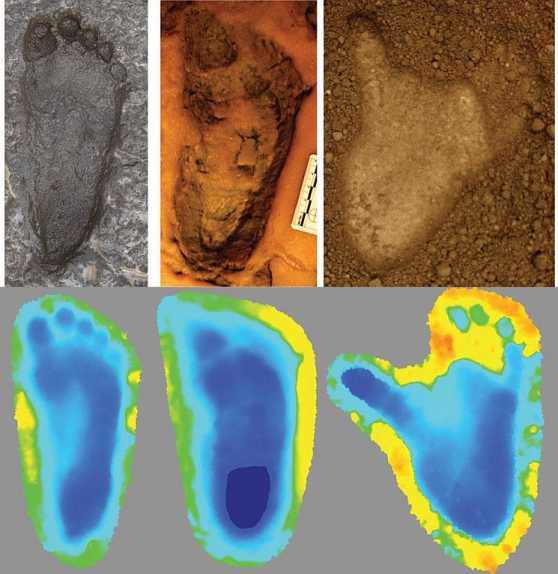41 barefoot humans, 2 chimpanzees and some fossil tracks that seem to be Pliocene (specifically 3.66million years old)Australopithecus afarensis have been extensively compared. The ancient footprints indicate a large limb flexing when the foot touches the ground and a flat-footed
landing. Both chimpanzee and human are very different in their walking, although the toes of both, humans particularly, make very obvious impressions in their tracks. The little hominin from Tanzania is also quite distinct, shaped in a human way, but with differing pressures exerted.
The fact that we are 2-legged is critical to our development, our cultures and to how we cope with modern
life since before the Stone Age. Bipedalism determines how we have made war, clothes, prepared food, and, most obviously, hunted. It has made our hand available as a tool and tool-maker and released the arms for throwing, holding and many other functions. Our frequent bad back-aches, are partly due to the genetic remainder of our quadrupedal ancestry, while those knees are barely suitable for purpose!
This gives great interest to the research that attempts to discover how our hominin bipedalism evolved into hominid walking, running and jumping. When the Pliocene saw the hominin tracks at Laetoli in Tanzania, this was the first known evidence of our ancestors 2-legged habit - in this case, probably walking. This means that whether they were Australopithecus or not is irrelevant. Hadar in Ethiopia has such fossil bones, but too many arguments rage over what the leg bones can indicate about gait.
The analysis took account of the big toe of the ancient hominins, which is orientated differently from ours. There was also a relatively deep impression made by the heel and midfoot, especially when compared to the toes, which made practically no impression compared to the gripping human phalanges. The famous fossil of Lucy
has often been said to have a pelvic shape that means the gluteal muscles could not have maintained any human-like balance or stability when walking. It is therefore no surprise that the authors of this paper also suggest a bent hip and bent knee approach to walking, just as the chimpanzee does, but to a much lesser extent. If you look at the footprint however, the obvious difference is the massive use of the chimpanzee hallux (big toe.)
Studying modern humans, we are aware that we are supremely modified to save energy when running or walking. This achievement was beyond or possible ancestor, as it is for the other apes. Home-range size for hominins would be more restricted than modern humans, and not just because of their small size. Tree climbing may well have been a more productive occupation than long-distance foraging.
This very interesting paper is produced today in the Proceedings of the Royal Society B, written by Kevin G. Hatala, Brigitte Demes and Brian G. Richmond of the Max Planck Institute for Evolutionary Anthropology, Leipzig and the George Washington University DC and Stony Brook University, NY, both in the US.










